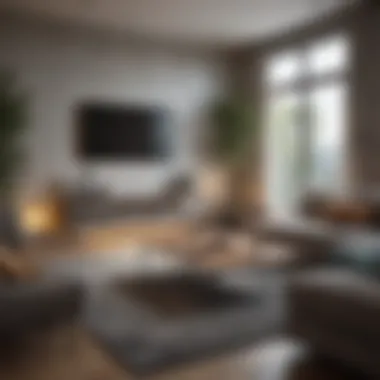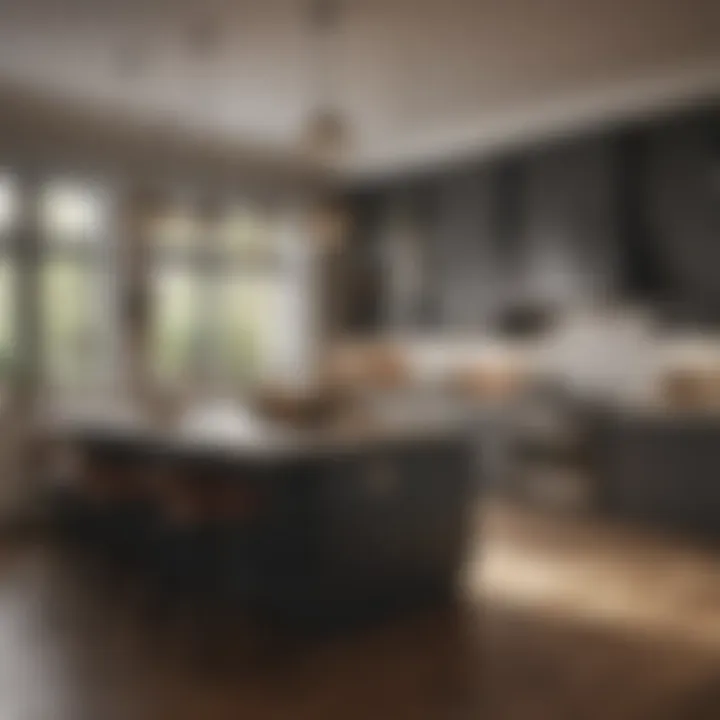Crafting Compelling Apartment Descriptions


Intro
The theme of apartment descriptions is often unduly overlooked yet holds significant weight in the real estate market. How potential renters or buyers perceive a living space can hinge on the descriptions provided in listings. A compelling description does more than inform; it paints a picture that guides the imagination toward envisioning life within those walls. This article will navigate the complexities involved in crafting high-quality apartment listings, focusing on elements that resonate with the target audience.
In this exploration, we aim to dissect not only the fundamental aspects of effective apartment descriptions—such as unique architectural features, optimal locations, and notable amenities—but also touch upon the psychological aspects tied to descriptive language. Ultimately, our goal is to empower homeowners and real estate professionals alike with insights and practical knowledge. This will assist in creating descriptions that not only attract attention but also lead to a deeper engagement from prospective buyers and renters.
Understanding the Importance of Apartment Descriptions
In the realm of real estate, the importance of well-crafted apartment descriptions cannot be overstated. They serve as the first point of contact with potential buyers and renters. A strong description can catch the eye and generate interest, while a poorly written one may result in missed opportunities. This section emphasizes the significance and nuances involved in creating effective apartment descriptions.
The apartment description is more than just a list of features. It shapes the perception of a property. A compelling narrative helps to paint a picture in the reader's mind about what life might look like in that space, engaging emotions and aspirations. Providing clear context about the property’s architectural style and interior design elements is vital. Not only does this information assist in establishing an image, but it also allows a potential renter or buyer to envision their future within those walls.
Furthermore, high-quality descriptions can enhance search engine optimization (SEO). By incorporating relevant keywords, these descriptions increase the likelihood of being found in online searches. These keywords should not feel forced but should easily blend into the text. This balance fosters both engagement and visibility.
Ultimately, a well-articulated apartment description conveys not just the physical attributes but also the lifestyle that comes with living in those spaces. It stands as a bridge between a listing and a buyer or renter’s decision-making process.
The Role of Descriptions in Real Estate
Descriptions play a crucial role in real estate marketing. They work alongside visuals to form a complete picture of a property. A description that authentically represents a property can prevent misunderstandings during viewings. High-quality content can also influence the pricing strategy. Descriptions that highlight unique features justify higher price points and attract more interested parties.
Every word counts. The goal is clarity and engagement, ensuring the audience takes action, whether that means scheduling a viewing or making an offer.
"A well-organized and thoughtful apartment description can differentiate a property in a crowded market."
Targeting the Right Audience
Identifying and targeting the right audience is foundational when crafting an apartment description. Different buyer personas search for varying aspects of a property. Young professionals may prioritize modern amenities and proximity to public transport, while families may seek spacious layouts and nearby schools. Understanding these needs is essential.
In this regard, utilizing demographic data can fine-tune messaging. Segmenting the audience allows for tailored descriptions that resonate on a personal level. This can drive engagement and create a personal connection, ultimately leading to a quicker sale or lease.
When composing descriptions, consider language that speaks directly to the intended audience. Whether it’s emphasizing the hustle and bustle of urban life or the tranquility of suburban living, a targeted approach can make a significant impact.
Key Components of an Apartment Description
An effective apartment description serves as a bridge between potential renters or buyers and the property itself. Understanding key components is paramount when crafting descriptions that catch attention and convey the essential features of an apartment. Each component plays a vital role in shaping perceptions and influencing decisions. Knowing specific elements to include can enhance the overall effectiveness of an apartment listing, leading to higher engagement and interest.
Architectural Features
Architectural features are fundamental to any apartment description. They encompass the unique elements that define the structure and style of the apartment. High ceilings, open floor plans, large windows, and specific architectural styles such as Art Deco or Modern can significantly influence buyer perception. These features not only add aesthetic appeal but also contribute to the overall functionality of the space.
When listing architectural features, it's crucial to be specific. Instead of saying "good layout," it’s far more effective to state, "this apartment features a spacious open floor plan with a sun-drenched living area and a separate dining room." This strategy provides potential buyers or renters with a clearer picture, making it easier for them to envision themselves in the space.
Interior Design Elements
Interior design elements are the next layer of an apartment's appeal. These details include colors, materials, furnishings, and overall decor style that can elevate an apartment's charm. Mentioning specific design choices, such as hardwood flooring, counter type, or tile design, can create a vivid impression.
For instance, stating "the kitchen is equipped with granite countertops and stainless steel appliances" conveys luxury and utility. Similarly, noting natural light from strategically placed windows can enhance the allure of the space.
The description should reflect a sense of coherence in design while appealing to the target audience’s taste. A contemporary apartment may benefit from mentioning sleek designs, while a rustic one would gain from highlighting warmth and tradition.
Location Attributes
Location is often regarded as the cornerstone of real estate. Describing the surrounding area is essential, as it plays a significant role in the desirability of an apartment. Potential residents often seek proximity to workplaces, schools, shops, parks, and public transport.


Instead of a generic statement about being in a "nice neighborhood," specify what makes the location unique. Phrases like "located just ten minutes from downtown" or "a block away from a vibrant local market" resonate more with potential buyers. For example, because of high walkability scores, mentioning nearby attractions or cultural landmarks can significantly enhance the apartment's appeal.
Amenities and Facilities
Amenities and facilities can distinguish one apartment from the next. Potential renters or buyers often consider what extras are offered beyond the living space itself. Examples might include gym access, swimming pools, communal gardens, or rooftop terraces. Specific amenities can directly impact the lifestyle of the residents.
When discussing amenities, it’s key to emphasize their relevance. For instance, saying "the building includes a state-of-the-art fitness center and a rooftop pool with stunning city views" would catch the attention of health-conscious individuals or those looking for leisure amenities. These details can round out the description and offer insights into the overall living experience residents can expect.
In summary, the key components of an apartment description blend architectural features, interior design, location attributes, and amenities into a compelling narrative. Each aspect is vital in presenting the property accurately and appealingly to the right audience.
Crafting the Perfect Description
Creating a compelling apartment description is not just an art; it is a necessary skill in today’s real estate market. The way we craft these descriptions can significantly influence how potential renters or buyers perceive a property. A well-structured description brings attention to the unique features of an apartment, engages the audience, and ultimately drives interest.
When crafting an effective description, there are several specific elements to consider. It involves understanding the target audience and what they value in a living space. Additionally, demonstrating attention to detail while maintaining brevity is crucial. Finally, weaving a visual narrative can help to establish an emotional connection with the reader.
Utilizing Strategic Keywords
Keywords serve as the bridge connecting potential renters or buyers to the property listing. They enhance search visibility and aid in reaching the target demographic. Selecting appropriate and specific keywords is essential. Terms like "luxury," "pet-friendly," or "near downtown" can draw more attention than vague references.
It's important to integrate these keywords naturally throughout the description. Overstuffing with keywords can detract from readability and diminish engagement. Aim to achieve a balance where the keywords enhance the description without overwhelming it. This strategy ensures that the listing will be optimized for search engines while remaining approachable and personable for the audience.
Balancing Detail and Brevity
Detail is necessary to paint a vivid picture of the apartment’s features. However, excessive detail can become tedious. The key to a successful description lies in striking a balance between providing enough information and keeping the content concise.
An effective approach includes focusing on the most important elements that set the apartment apart. For instance, mention unique layouts, high-end finishes, or any distinct architectural features without diving into excessive specifics. Using bullet points can also help clarify the most appealing aspects in a quick, digestible format.
Creating a Visual Narrative
The ability to create a visual narrative is a significant advantage in writing apartment descriptions. This narrative should guide the reader through the experience of living in the space.
Start by creating an image in the reader's mind. Describe not just the physical attributes but also the lifestyle that comes with living there. For instance, rather than just saying there is a balcony, explain how it provides a perfect spot for morning coffee or evening relaxation.
Incorporate sensory details—such as the warm sunlight filtering through the large windows or the quiet ambiance of the local neighborhood. This approach helps foster a connection between the reader and the property. Effectively creating such a narrative enhances the allure of the listing and encourages potential tenants or buyers to imagine themselves in that space.
"A strong apartment description can transform an average listing into an attractive opportunity."
By honing in on these elements—strategic keyword usage, the balance of detail, and visual storytelling—your apartment descriptions will resonate more effectively with prospective residents, making them not just informative, but also captivating.
The Psychological Impact of Descriptive Language
Descriptive language in apartment listings is not merely a tool for providing information. It plays a significant role in shaping potential buyers' and renters' perceptions. When done correctly, this strategic use of language can augment interest, create emotional connections, and influence decision-making. The psychological elements at play are complex but essential to understand for anyone involved in real estate.
The right words can resonate with individuals, activating feelings of comfort, excitement, or belonging. When potential residents read descriptions that evoke a sense of warmth and adhere to their aspirations, they are more likely to envision themselves in that space.
Words that Create Connection
Certain words are more than just descriptors; they can inspire a connection with the space. Words like "cozy," "inviting," and "tranquil" help impart an emotional quality to an apartment. These vocabulary choices can shift focus from just square footage or facilities, to the very essence of living within those walls.
Consider these points when crafting descriptions:
- Create a Mood: Use words that evoke emotions. "Sun-drenched" rather than simply "bright" can elicit images of happiness and warmth.
- Appeal to Sensory Experience: Include terms that engage the senses, such as "soft textures" or "vibrant colors."
- Personal Touch: Phrases that reflect a friendly tone can invite a personal connection, making a listing feel less transactional.


Overall, the selection of language is crucial in forming connections, which can lead to interest in viewing the space.
Emotional Appeal in Descriptions
The ability of a description to convey emotion can be a powerful motivator for potential renters or buyers. Emotions are often more persuasive than facts alone. Emotionally appealing descriptions can drive engagement and prompt action, such as booking a viewing.
Several strategies can enhance the emotional appeal of an apartment description:
- Storytelling: Instead of just listing features, tell a story about the living experience. For example, describing morning rituals in a sunlit kitchen can create vivid imagery.
- Highlight Unique Features: Emphasize unique traits that might resonate emotionally with the audience. A private garden can be a sanctuary; mention how it provides a personal retreat.
- Empathy: Understand the target audience's needs. A family-oriented space might be described with a focus on safety and community amenities, while a bachelor pad could emphasize nightlife and energy.
"Descriptions that connect emotionally can bridge the gap between mere interest and genuine desire, encouraging buyers or renters to envision themselves thriving in that apartment."
In summary, the psychological impact of descriptive language cannot be undervalued. By choosing words that forge connections and evoke emotion, real estate professionals can create compelling narratives that attract potential tenants and buyers. This strategy not only makes apartment listings stand out but also aligns with the aspirations and emotions of the target audience.
Common Mistakes in Apartment Descriptions
Describing an apartment goes beyond listing its features. It involves capturing its essence, which can directly influence potential buyers or renters. However, many descriptions fall short due to common mistakes. Recognizing and avoiding these pitfalls is essential for creating effective content. When crafted correctly, descriptions can evoke interest and set a property apart in a competitive market.
Overused Adjectives
One of the significant issues in many apartment descriptions revolves around reliance on overused adjectives. Terms like "cozy," "charming," and "spacious" are frequently employed. While these words aim to evoke a positive image, their excessive use often leads to descriptions that feel generic or insincere. It is essential to move beyond clichés and choose words that genuinely represent the property's unique attributes.
A good strategy here is to showcase specific features that provide a clearer picture. For example, instead of saying "cozy living room," highlight features such as "a living room with warm lighting and comfortable seating for intimate gatherings." Lists of standout features can be beneficial, such as:
- Custom cabinetry in the kitchen
- Hardwood flooring throughout the apartment
- Large windows providing natural light
Employing precise terms makes the description more engaging and appealing to serious buyers or renters.
Neglecting Descriptive Balance
The balance between detail and clarity is crucial in crafting effective apartment descriptions. Many descriptions either include too much detail, overwhelming potential renters or buyers, or lack sufficient information, leaving too many questions. Both situations can drive interest away.
To achieve a well-balanced description, it is important to:
- Be concise. Each sentence should serve a purpose without adding unnecessary fluff.
- Use bullet points. Highlighting key features can help break up text and make vital information easily digestible.
- Prioritize information. Start with the most appealing aspects of the apartment, like its unique selling points.
A well-structured listing should provide enough information to inform potential clients without drowning them in too much data.
The critical balance in apartment descriptions lies in ensuring clarity while providing sufficient detail to inspire interest.
By being attentive to these common mistakes, writers can develop more impactful descriptions that better connect with the target audience.
Evolving Trends in Apartment Descriptions
Understanding the evolving trends in apartment descriptions is essential for anyone involved in real estate. The market is dynamic, influenced by consumer preferences and societal changes. Awareness of these trends can help homeowners and real estate agents effectively market their properties. As buyers and renters become more discerning, the goal is to capture their attention through well-thought-out descriptions.
In this section, we will dissect two prominent trends: sustainability and technology integration. Both play significant roles in shaping the perception of modern apartments.
Sustainability as a Feature
Sustainability has gained importance in today's housing market. More consumers prioritize eco-friendly living. They seek apartments that reflect their values, including energy efficiency, green materials, and sustainable practices.
When positioning an apartment for sale or rent, highlighting sustainability can be beneficial. Possible features to mention include:


- Energy-efficient appliances: Such appliances consume less energy, which reduces utility bills.
- Sustainable materials: Features like bamboo flooring or recycled countertops resonate with eco-conscious individuals.
- Solar panels: These can significantly lower energy costs and appeal to a growing segment of green-minded buyers.
- Water-saving fixtures: Low-flow faucets and efficient irrigation systems also attract environmentally aware residents.
By emphasizing these elements in your descriptions, you not only appeal to a niche market but also enhance the overall attractiveness of the property.
"Sustainability in real estate isn't just a trend; it represents a shift in how we think about living spaces and our environment."
Technology Integration
Incorporating technology into apartment descriptions has also become essential. Smart home features have shifted from luxury add-ons to standard expectations among many renters and buyers. Descriptions should reflect the modern conveniences that technology offers. Highlighting these aspects can include:
- Smart thermostats: These devices help regulate heating and cooling effectively, saving energy.
- Home automation systems: Mention how one can control lighting, security cameras, and other systems with a smartphone.
- High-speed internet access: In today's digital age, robust internet connectivity is crucial for remote work and entertainment.
- Smart security features: Advanced locks or alarm systems can provide peace of mind for potential renters.
Integrating technology into an apartment description not only resonates with tech-savvy individuals but also reflects a modern lifestyle.
Real-Life Case Studies
Studying real-life case studies in the realm of apartment descriptions provides invaluable insights. These examples show how effective descriptions can influence prospects and secure deals. By examining successful listings and learning from failures, stakeholders can fine-tune their strategies for promoting properties. The significance of real-life case studies is in their ability to showcase best practices and highlight pitfalls.
Successful Apartment Listings
Successful apartment listings often share certain traits that make them stand out in a competitive market. Here are some crucial elements:
- Clear and Descriptive Language: The language used in successful descriptions is precise. It paints a vivid picture without overstating the features. This balance allows potential renters or buyers to visualize the space.
- Highlighting Unique Features: Distinct architectural elements or unique amenities, such as a sun-soaked terrace or custom cabinetry, can attract interest. Emphasizing these features helps differentiate the listing from others in the area.
- Utilizing Strategic Keywords: Keywords related to location, amenities, and lifestyle are essential. Listings that include terms like "walkable neighborhood" or "pet-friendly" can draw in targeted audiences.
"Effective descriptions create a strong first impression, influencing a viewer's perception before they even step inside the apartment."
Successful examples illustrate how well-written descriptions lead to quicker sales and rentals, underscoring the necessity of mastering writing these listings.
Lessons Learned from Failures
Not every apartment listing succeeds. Analyzing failure stories reveal significant learning points:
- Avoiding Generic Descriptions: Listings that rely on cliches or overly general terms fail to engage. Phrases like "nice view" or "spacious layout" do not provide meaningful details.
- Neglecting to Update Information: Outdated features or incorrect details can lead to mistrust. A listing that fails to accurately represent the apartment will deter potential renters.
- Underestimating the Power of Visuals: Poor or no photographs exacerbate the shortcomings of descriptive text. Images play a vital role in supporting the description and providing tangible evidence of the apartment's appeal.
In reflecting on these factors, real estate professionals can refine their approach. They can focus on enhancing their descriptions to ensure future endeavors reflect the lessons learned from past mistakes.
Ending: The Future of Apartment Descriptions
The domain of apartment descriptions is evolving. As real estate continues to change, so must the strategies used to create compelling narratives about living spaces. The release of new technologies and shifting preferences among potential renters and buyers dictate that descriptions not only convey information but also resonate with the audience on a personal level. An effective description encapsulates the spirit of a home while highlighting its unique offerings. This balance is crucial for standing out in a crowded market.
One significant factor in shaping the future of these descriptions is the integration of feedback for improvement. Real estate agents and homeowners should actively seek input about their descriptions from various sources. Understanding how audiences react to language, tone, and specific details can provide insights that may not have been initially evident. Implementing changes based on constructive criticism can enhance the appeal of a listing, making sure it aligns with what consumers want.
"Feedback leads to refinement. What was once just a description can turn into a captivating narrative when adjusted based on what resonates with the audience."
Integrating Feedback for Improvement
Feedback serves as a tool for continual enhancement. It is vital for understanding the aspects that attract or repel potential tenants or buyers. Regularly soliciting opinions can involve a variety of methods, including:
- Surveys: Gather direct opinions from previous clients about what elements drew their interest.
- Social Media Engagement: Utilize platforms like Reddit and Facebook to seek spontaneous reactions toward different description styles.
- A/B Testing: Experiment with different versions of descriptions across multiple listings and analyze performance data.
Evaluating this feedback allows for a more tailored approach, ensuring that descriptions not only contain mandatory information but also reflect current market trends and preferences. Employing this strategy increases the chances of capturing the attention of potential clients.
The Importance of Continuous Learning
Staying relevant in the real estate market requires a commitment to continuous learning. Trends fluctuate rapidly, influenced by societal changes, economic factors, and consumer behavior. It is essential for real estate professionals to keep abreast of these shifts, encompassing:
- Educational Resources: Engaging in courses or reading articles on the latest marketing techniques and property descriptions.
- Networking: Collaboration and discussions with peers can expose agents to innovative approaches that enhance their description crafting.
- Market Research: Analyzing competitor listings can yield insights into what works and what does not, allowing for adjustments based on successful strategies.
By embracing a mindset of ongoing improvement and openness to new information, those in the real estate field can master the art of apartment descriptions more effectively. This evolves into a significant advantage within a competitive marketplace, ultimately leading to increased interest and successful transactions.















